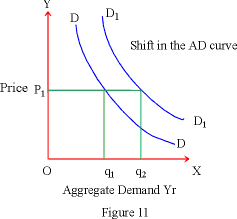|
(C) The Three Effects: There are three
different effects operating on the aggregate demand as a result
of rising price level, or under inflationary conditions. These are
Wealth Effect, Rate of interest Effect and Trade Effect.
i) Wealth Effect: Professor A.C. Pigou had
first stated and analyzed wealth effect under inflationary conditions
of the price level changes. With a rise in the price level, value
of the given money income of consumers (assuming supply of money
to be constant) decreases. With a fall in the purchasing power of
their income consumers become poorer and have to reduce their consumption.
By way of an example a person with fixed money income of $100 can
purchase 25 units of a commodity, price of the commodity being $4.
But he can purchase only 20 units of the commodity when price rises
to $5. Thus the real income or wealth of a consumer diminishes
from 25 to 20 even when his money income is constant. Such a
wealth effect results in the consumer reducing his demand with a
rising price level. Contrary would be the case under the conditions
of deflation and falling prices. In that case his wealth effect
will be positive and enable him to purchase larger quantities of
all goods and services. Hence the presence of the wealth effect
continues to maintain an inverse relation between price level changes
and aggregate demand.
ii) Rate of interest Effect: Rate of interest
is also a price like all other prices of goods and services. It
is the price paid for the use of money or for the use of loanable
funds. Rate of interest also shows a tendency to move upward under
inflationary conditions or rising prices. With rising price level
and with a constant supply of money, there is an increased demand
for liquidity or money and credit resources. This is because
the rising price level reduces purchasing power of money.
Hence a greater quantity of money is needed to carry out a given
volume of transactions. Both households and producers create an
increased demand for money under conditions of rising price level.
Consequently, with constant supply, growing demand for money tends
to raise its price in the form of rate of interest.
With higher rates of interest, borrowing becomes dearer and the
tendency to save rather than consume is induced. Consequently demand
for goods and services both from consumers and investors starts
declining. Therefore a rising level of prices results in a fall
in the aggregate demand due to a rise in the rate of
interest.
iii) Trade Effect: Rising level of prices finally causes
fall in the aggregate demand via foreign trade effect. Under the
conditions of inflation domestic prices of goods are higher than
international price levels. This makes import of goods attractive
since import prices are lower and goods are cheaper than domestic
products. Again because of an inflationary rise in the prices of
export goods, foreign demand for exported goods declines. Both these
processes together reduce demand for domestically produced
goods and services.
(D) Shifts in Demand: As in the case of the individual
demand curve, aggregate demand curve shows a tendency to shift leftward
or rightward. The demand curve shifts in this manner when aggregate
demand tends to rise without any change in the domestic price
level. In other words this occurs when aggregate demand alters for
causes other than changes in the price level.
There are a variety of such causes contributing to shifts in aggregate demand. When the public authority increases its expenditure, more purchasing power is put in the hands of people who create an increasing demand. If the rates of taxes are reduced then again people’s capacity to spend increases and aggregate demand will rise. International demand and supply conditions may also contribute to shifts in the aggregate demand curve. Rising price level in countries abroad may make exports of a country relatively cheaper and cause an increased demand for exports. On the contrary under such conditions imported goods become relatively dearer, the demand for which declines and this results in a rise in demand for indigenous products. When all these factors are moving in the opposite direction, they will result in a fall in the aggregate demand and rightward shift in the AD curve.

In figure 11, DD is the original demand curve. On this demand curve at a given price level P1 aggregate demand is of the size q1. But when the demand curve shifts rightward or upward, as D1D1 then at the same price level P1 demand increases from q1 to q2. This means that there has been an increase in demand at the same price. If we consider the higher demand curve D1D1 to be the initial demand curve, then the demand curve DD denotes leftward or downward shift. This time it means that at the same price there has been a decrease in demand.
|